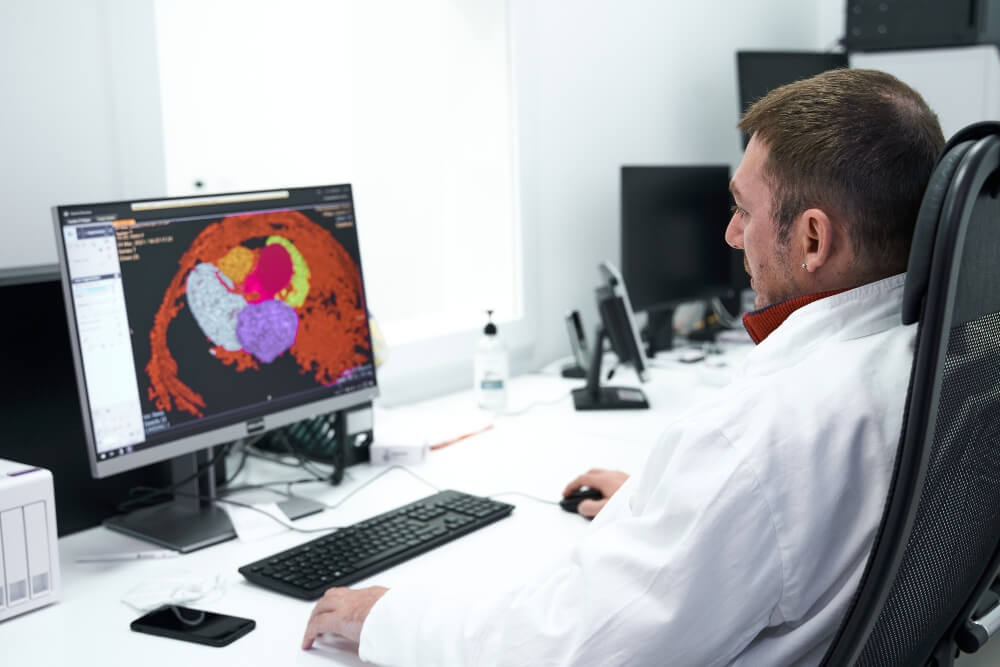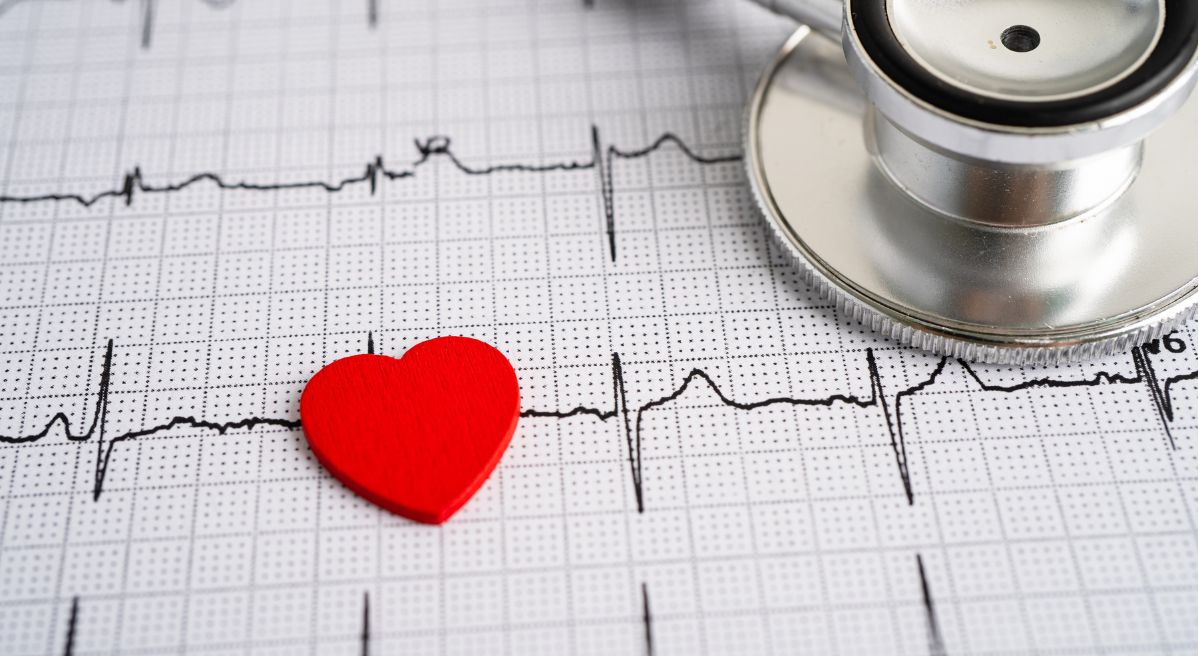If you wish to schedule a cardiology examination in Belgrade, choose a place where the service is both high-quality and efficient. You don’t want to give up on such important matters due to long waiting times.
What is cardiomyopathy?
Cardiomyopathy is a disease of the heart muscle that results in changes to the heart muscle such as:
- Reduced thickness or thinning
- Enlargement
- Reduced elasticity
Untreated cardiomyopathy can have serious consequences, as the heart eventually becomes unable to pump enough blood, which can also affect its electrical activity. As a result, patients are often diagnosed with heart failure, which is a potentially fatal condition.

What types of cardiomyopathy exist?
Based on whether it is possible to determine the cause of this disease, cardiomyopathy can be classified as primary (unknown cause) or secondary (the cause is known). However, the more important classification is into these four types:
Dilated cardiomyopathy
In this type of cardiomyopathy, the heart chambers become dilated (enlarged). When the heart muscle is damaged and its pumping function weakens, the entire body tries to compensate for the problem. As a result, the kidneys start retaining a certain amount of fluid in the body to expand the heart chambers. Initially, the enlarged chambers may enhance blood pumping, but this cannot be sustained in the long term. Soon, cardiomegaly, which is the enlargement of the heart chambers, occurs.
At a certain point, the pressure on the heart becomes overwhelming, causing its function to deteriorate and weaken. Additionally, the fluid that the kidneys fail to excrete starts accumulating in the extremities and other parts of the body. This type of cardiomyopathy is one of the most prevalent and can be diagnosed at almost any age, including in children, but it is most common in middle-aged men.
The consequences of this disease are serious and include:
- Swelling in the legs, abdomen, and lungs
- Heart failure
- Embolism
- Arrhythmias
- Sudden cardiac death
Hypertrophic cardiomyopathy
Hypertrophic cardiomyopathy is characterized by excessive thickening of the heart muscle, which impairs its ability to pump blood. It also affects the conduction system of the heart. Sometimes, it is impossible to determine the exact cause of this problem, but when it can be identified, genetics are often to blame, and less commonly, high blood pressure.
The consequences can vary and may include:
- Blood flow problems: Blood may be retained in the lungs instead of being adequately pumped into the heart.
- Blood flow problems between chambers and atria.
- Cardiac insufficiency.
- Dilated cardiomyopathy: This type can progress into another, equally dangerous form
Restrictive cardiomyopathy
When there is impaired filling of the heart chambers due to reduced elasticity and increased stiffness of their walls, it is called restrictive cardiomyopathy. In this disease, initially, the ability of the heart to expand and fill with blood is compromised, and later, the pumping of blood may also become impaired. This form of cardiomyopathy is less common and can be caused by conditions such as hemochromatosis, sarcoidosis, amyloidosis, chemotherapy, or it can be idiopathic, meaning of unknown origin.
The consequences of this disease include:
- Arrhythmias
- Formation of blood clots
- Cardiac insufficiency
Arrhythmogenic right ventricular dysplasia
This disease involves the right ventricle, where there is a replacement of normal heart muscle tissue with fatty or fibrous tissue. It is typically of hereditary nature.
Consequences:
- Arrhythmia
- Cardiac insufficiency
- Sudden cardiac death
Symptoms of cardiomyopathy
In most cases, the symptoms of this disease begin to appear in the advanced stages and can vary depending on the specific type of cardiomyopathy.
You may notice that the symptoms are similar to other heart problems, so it is necessary to see a specialist as soon as possible for proper diagnosis and initiation of treatment.
Symptoms of dilated cardiomyopathy include:
- Weakness
- Fatigue
- Dizziness or fainting
- Frequent drowsiness and lack of concentration
- Appetite problems and nausea
- Breathing difficulties during physical activity and when lying flat
- Dry cough
- Swelling of the legs (calves, feet), abdomen
- Weight gain due to fluid retention
- Arrhythmias
Symptoms of hypertrophic cardiomyopathy include:
- Chest pain during certain activities, and sometimes at rest
- Breathing difficulties during physical activity, and sometimes at rest
- Fainting and dizziness
- Sudden onset of fatigue
- Arrhythmias
Symptoms of restrictive cardiomyopathy include:
- Heart function problems and arrhythmias
- Weight gain despite poor appetite
- Syncope – sudden loss of consciousness
- Fainting during physical activities
- Formation of blood clots in the lower extremities or abdomen
- Inability to perform daily activities
Symptoms of arrhythmogenic right ventricular dysplasia include:
- Sudden cardiac death
- Heart rhythm problems, skipping beats, palpitations
Why does cardiomyopathy occur?
The reasons for the occurrence of this heart muscle disease can be:
- Unknown origin
- Hereditary factors
- Acquired problems
Health issues that can trigger cardiomyopathy are usually related to high blood pressure, thyroid disorders, prolonged arrhythmias, diabetes, hemochromatosis, sarcoidosis, amyloidosis, and COVID-19. In addition, long-term excessive alcohol and drug use, obesity, vitamin B12 deficiency, and chemotherapy can be associated with the development of this condition.
How is cardiomyopathy diagnosed?

Diagnosing cardiomyopathy is not difficult, as there are many effective methods to assess the anatomy of the heart and its cardiac muscle. It’s important to know that a routine preventive examination by a cardiologist, which includes an echocardiogram, can sometimes be sufficient to detect this disease or raise suspicion of its presence. If someone in your family has already been diagnosed with cardiomyopathy, preventive examinations are necessary. In the case of children, it is recommended to have an echocardiogram and ECG once a year until the age of 18, and then every 5 years.
In case there is suspicion of any of these heart problems, the cardiologist may refer you to some of the following tests:
- Echocardiogram (ultrasound) – a painless and harmless way for the doctor to quickly assess if there are any thickening of the heart muscle and potential abnormalities in blood flow.
- Electrocardiogram (ECG) – an important method for monitoring the electrical activity of the heart and easily detecting arrhythmias.
- 24-hour Holter monitor – it tracks the electrical activity of the heart over a 24-hour period since irregularities may not be immediately noticeable on a single EKG.
- Cardiac magnetic resonance imaging (MRI) – used when ultrasound is unable to detect or clearly visualize certain changes, providing more detailed information in a safe and painless manner.
- Cardiac catheterization – an invasive method recommended only when necessary for precise measurement of blood pressure in the heart and similar data.
Treatment of cardiomyopathy
The treatment greatly depends on the type of the disease, the stage at which the patient is, and their overall condition. In some cases, medication therapy combined with dietary and lifestyle changes may be sufficient. Severe cases may require surgical procedures to remove thickened areas, while elderly patients who are not suitable for surgery may receive pacemakers to regulate the electrical activity of the heart, which is compromised due to cardiac weakness.
There is no cardiovascular-related condition that can be ignored without dangerous consequences. For this reason, it is important to take any symptoms seriously.
At the Pulse Cardiology Center, it is possible to undergo all necessary analyses and interventions for the detection and treatment of heart problems. Schedule an appointment with us and safeguard your heart.





